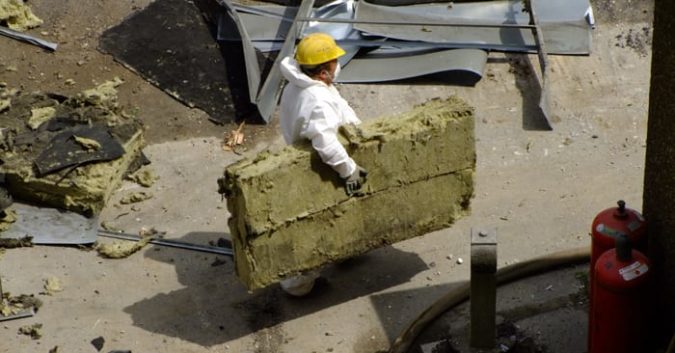On April 17, the Environmental Protection Agency (EPA) issued a new rule that makes sure discontinued uses of asbestos products cannot re-enter the American market without EPA review. Supporters of the new restrictions, known as the April 2019 Final Rule, say an important loophole has been closed.
“Prior to this new rule, EPA did not have the ability to prevent or restrict certain asbestos products from being reintroduced into the market,” said EPA Administrator Andrew Wheeler. With the new rule in place, and ongoing risk evaluations of current uses of asbestos, Wheeler claims the agency has “unprecedented authorities to protect public health.”
Not everyone is so sure that the new rule will be effective. Linda Reinstein, the president and CEO of the Asbestos Disease Awareness Organization (ADAO), called new regulations “toothless.” According to ADAO, roughly 40,000 deaths per year are linked to asbestos in the United States.
“More than 60 nations around the world have put public health before private profits and banned asbestos,” Reinstein told the New York Times. “Americans deserve the same from our government.”
Essentially, the EPA is only banning asbestos uses that are no longer used, and many in the asbestos prevention community are feeling shortchanged. Recently, Wheeler told Congress that he would ban ongoing uses of asbestos. That has not happened. Under the new rule, ongoing asbestos uses in America are under risk evaluation, but allowed to continue.
“Just last week, Administrator Wheeler sat before my committee and committed to an outright ban of ongoing uses of asbestos,” said U.S. Representative Frank Pallone Jr. (D-NJ), Chairman of the House Committee on Energy and Commerce. He continued:
“Today’s rule is a complete betrayal of that commitment. It does nothing to restrict ongoing uses of asbestos; instead it provides a pathway to market for uses that had previously been phased out, such as in floor tiles and insulation.”
It seems like, depending on where one stands, the new rule is either a very good or very bad development in the fight to keep our country safe from asbestos.
Understanding the EPA April 2019 Final Rule
To understand the purpose of the new rule, it is helpful to have a little bit of background about the actions taken by the EPA to protect the public from asbestos. Under the Toxic Substances Control Act (TSCA), the EPA is required to regulate the manufacture and sale of chemicals.
The 1989 Partial Ban on asbestos forbid the importation, processing, and distribution of some asbestos-containing products, including:
- Corrugated Paper
- Rollboard
- Commercial Paper
- Specialty Paper
- Flooring Felt
- “New Uses.” That is to say, all new uses of asbestos (after August 25, 1989) were banned from entering the American market.
In the 30 years since the partial ban, many asbestos products and uses have been discontinued even though they were not outlawed by the EPA. As the public learned more about the dangers of asbestos exposure, demand for products that incorporated this dangerous mineral declined naturally.
The April 2019 Final Rule formally bans the uses of asbestos that have gone out of fashion. In other words, if an asbestos product is no longer on the market (but it was not formally banned in 1989), it cannot come back into the market without an EPA review. The uses covered by the new rule include:
- Adhesives, sealants, roof and non-roof coatings
- Arc chutes
- Beater-add gaskets
- Cement products
- Extruded sealant tape and other tape
- Filler for acetylene cylinders
- Friction materials
- High grade electrical paper
- Millboard
- Missile liner
- Packings
- Pipeline wrap
- Reinforced plastics
- Roofing felt
- Separators in fuel cells and batteries
- Vinyl-asbestos floor tile
- Woven products
- Other building products
The April 2019 final rule is the first time in 30 years that the EPA has taken action on asbestos under the TSCA. Without this rule, all of the above asbestos products that were not on the market could have come back without any roadblocks.
Ongoing Risk Evaluations of Asbestos Under TSCA. As part of the amended TCSA under the Frank R. Lautenberg Chemical Safety for the 21st Century Act, the EPA is required to evaluate the asbestos and take swift action should they find an unreasonable risk associated with the few remaining uses of asbestos in America.
Asbestos Remains Legal and Lethal in the United States
Many had hoped that, with the passage of Lautenberg, the EPA would take the sensible step of banning asbestos outright and addressing the vast amounts of legacy asbestos present in millions of homes, schools, and workplaces across the country.
Unfortunately, in the words of Linda Reinstein, “This rule is not a ban. In fact, it falls woefully short of taking meaningful action to protect public health.” Read ADAO’s 10 Ways the New Rule Fails to Protect the Public from Asbestos to understand the asbestos prevention community’s take on how the EPA has punted on their responsibility.
“The EPA should be protecting Americans from this toxic substance, not inviting manufacturers to revive its use in our homes,” said Rep. Pallone. “Today’s action is shamefully inadequate, runs counter to the commitment Administrator Wheeler made to me last week, and only strengthens my resolve to pass a legislative solution.”
A legislative solution may be the only solution. Fortunately, the Alan Reinstein Ban Asbestos Now Bill of 2019 (ARBAN), named in honor of Linda’s late husband, has been introduced in both the House and the Senate.
Unlike the tepid restrictions imposed by the EPA, ARBAN bans asbestos outright and lays out a blueprint for the country to reckon with the legacy asbestos waiting to poison millions more Americans.
Call your elected officials today and let them know that America cannot wait on the EPA to make the right decision any longer. People’s lives are on the line.
